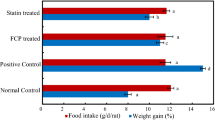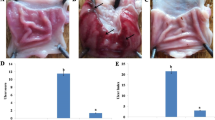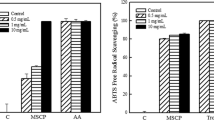Abstract
The objective of this study was to investigate the hepatoprotective effect of cod skin collagen peptides (CSCP), isolated from fishing industrial by-products, in vitro and in vivo. Effect of CSCP on cell proliferation of normal and H2O2-damaged Chang liver cells was determined by MTT assay in vitro. Two animal models, CCl4-induced and acetaminophenum-induced acute hepatotoxicity, were established to assess the hepatoprotective effect of CSCP. Liver weight index, serum ALT and AST, antioxidant enzymes, and lipid peroxidation product were used as the markers of liver toxicity. The cell viability in the H2O2-treated Chang liver cells was remarkably increased when pretreated with CSCP from 100 to 1,000 µg/ml in a dose-dependent manner. CSCP pretreatment also alleviated the CCL4-induced liver index loss, while no marked changes were found in acetaminophenum-treated mice. Furthermore, CSCP pulled down serum ALT and AST level, increased the activities of SOD and CAT, and decreased MDA in both murine models of acute liver toxicity. Pretreatment with CSCP protected liver tissue against oxidative injure in vivo and in vitro. The underlying mechanism might involve enhancement in the activities of antioxidant enzymes and reduction in the lipid peroxidation.





Similar content being viewed by others
References
Shoulders, M. D., & Raines, R. T. (2009). Collagen structure and stability. Annual Review of Biochemistry, 78, 929–958.
Gómez-Guillén, M. C., Giménez, B., López-Caballero, M. E., & Montero, M. P. (2011). Functional and bioactive properties of collagen and gelatin from alternative sources: A review. Food Hydrocolloids, 25, 1813–1827.
Kaewdang, O., Benjakul, S., Kaewmanee, T., & Kishimura, H. (2014). Characteristics of collagens from the swim bladders of yellowfin tuna (Thunnus albacares). Food Chemistry, 15(155), 264–270.
Senevirathne, M., & Kim, S. K. (2012). Utilization of seafood processing by-products: Medicinal applications. Advances in Food and Nutrition Research, 65, 495–512.
Jayathilakan, K., Sultana, K., Radhakrishna, K., & Bawa, A. S. (2012). Utilization of byproducts and waste materials from meat, poultry and fish processing industries: A review. Journal of Food Science and Technology, 49(3), 278–293.
Wang, B., Wang, Y. M., Chi, C. F., Luo, H. Y., Deng, S. G., & Ma, J. Y. (2013). Isolation and characterization of collagen and antioxidant collagen peptides from scales of croceine croaker (Pseudosciaena crocea). Marine Drugs, 11(11), 4641–4661.
Jia, J., Zhou, Y., Lu, J., Chen, A., Li, Y., & Zheng, G. (2010). Enzymatic hydrolysis of Alaska pollack (Theragra chalcogramma) skin and antioxidant activity of the resulting hydrolysate. Journal of the Science of Food and Agriculture, 90(4), 635–640.
Gómez-Guillén, M. C., López-Caballero, M. E., de López de Lacey, A., Alemán, A., Giménez, B., & Montero, P. (2010). Antioxidant and antimicrobial peptide fractions from squid and tuna skin gelatin. In E. Le Bihan & N. Koueta (Eds.), Sea by-products as a real material: New ways of application (p. 89e115). Kerala: Transworld Research Network Signpost.
Saito, M., Kiyose, C., Higuchi, T., Uchida, N., & Suzuki, H. (2009). Effect of collagen hydrolysates from salmon and trout skins on the lipid profile in rats. Journal of Agriculture and Food Chemistry, 57(21), 10477–10482.
Zhang, Z., Wang, J., Ding, Y., Dai, X., & Li, Y. (2011). Oral administration of marine collagen peptides from Chum Salmon skin enhances cutaneous wound healing and angiogenesis in rats. Journal of the Science of Food and Agriculture, 91(12), 2173–2179.
Zhuang, Y., Hou, H., Zhao, X., Zhang, Z., & Li, B. (2009). Effects of collagen and collagen hydrolysate from jellyfish (Rhopilema esculentum) on mice skin photoaging induced by UV irradiation. Journal of Food Science, 74(6), H183–H188.
Chai, H. J., Li, J. H., Huang, H. N., Li, T. L., Chan, Y. L., Shiau, C. Y., et al. (2010). Effects of sizes and conformations of fish-scale collagen peptides on facial skin qualities and transdermal penetration efficiency. Journal of Biomedicine and Biotechnology, 2010, 757301.
Yamada, S., Nagaoka, H., Terajima, M., Tsuda, N., Hayashi, Y., & Yamauchi, M. (2013). Effects of fish collagen peptides on collagen post-translational modifications and mineralization in an osteoblastic cell culture system. Dental Materials Journal, 32(1), 88–95.
Chalamaiah, M., Dinesh Kumar, B., Hemalatha, R., & Jyothirmayi, T. (2012). Fish protein hydrolysates: Proximate composition, amino acid composition, antioxidant activities and applications: A review. Food Chemistry, 135(4), 3020–3038.
Yamamoto, K., Igawa, K., Sugimoto, K., Yoshizawa, Y., Yanagiguchi, K., Ikeda, T., et al. (2014). Biological safety of fish (tilapia) collagen. BioMed Research International, 2014, 630757.
Gnanadesigan, M., Ravikumar, S., & Inbaneson, S. J. (2011). Hepatoprotective and antioxidant properties of marine halophyte Luminetzera racemosa bark extract in CCL(4) induced hepatotoxicity. Asian Pacific Journal of Tropical Medicine, 4(6), 462–465.
Fakurazi, S., Sharifudin, S. A., & Arulselvan, P. (2012). Moringa oleifera hydroethanolic extracts effectively alleviate acetaminophen-induced hepatotoxicity in experimental rats through their antioxidant nature. Molecules, 17(7), 8334–8350.
Acknowledgments
This work was supported by Agricultural Science and Technology Program of Qingdao (Grant No.14-2-3-50-nsh).
Conflict of interest
The authors declare that there is no conflict of interests regarding the publication of this paper.
Author information
Authors and Affiliations
Corresponding author
Rights and permissions
About this article
Cite this article
Han, Y., Xie, J., Gao, H. et al. Hepatoprotective Effect of Collagen Peptides From Cod Skin Against Liver Oxidative Damage In Vitro and In Vivo. Cell Biochem Biophys 71, 1089–1095 (2015). https://doi.org/10.1007/s12013-014-0313-x
Published:
Issue Date:
DOI: https://doi.org/10.1007/s12013-014-0313-x




